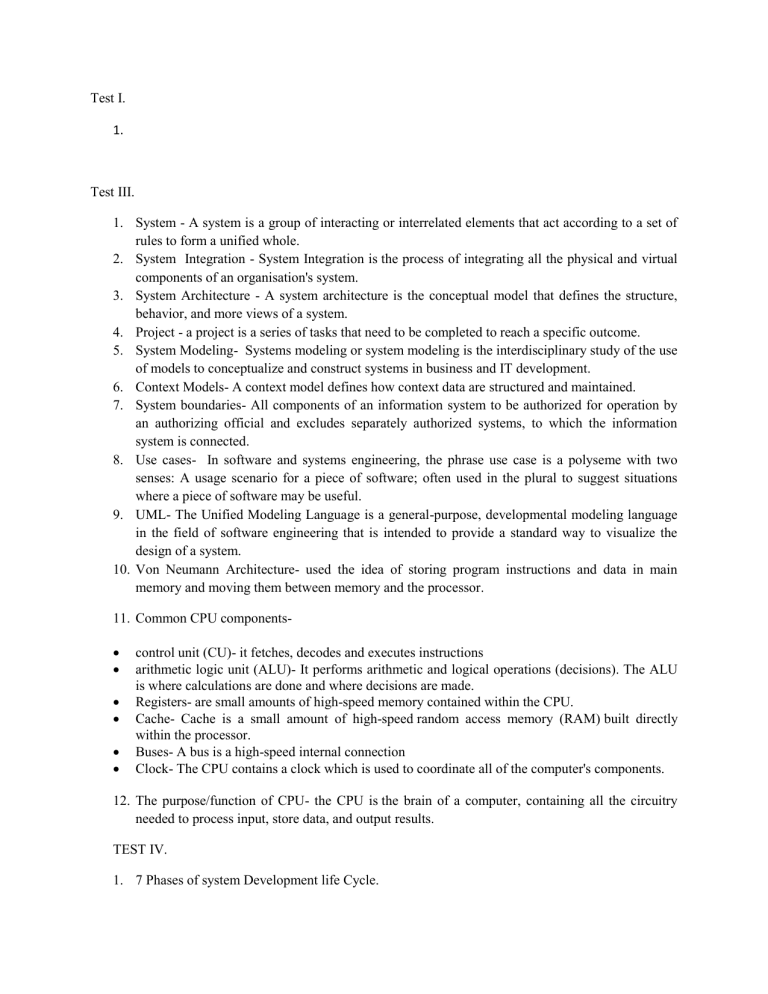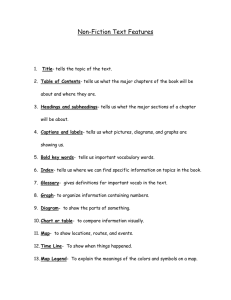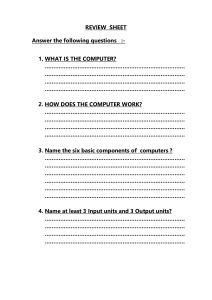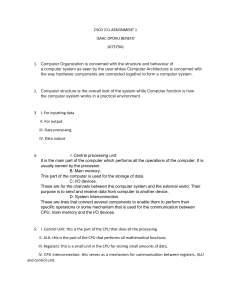
Test I. 1. Test III. 1. System - A system is a group of interacting or interrelated elements that act according to a set of rules to form a unified whole. 2. System Integration - System Integration is the process of integrating all the physical and virtual components of an organisation's system. 3. System Architecture - A system architecture is the conceptual model that defines the structure, behavior, and more views of a system. 4. Project - a project is a series of tasks that need to be completed to reach a specific outcome. 5. System Modeling- Systems modeling or system modeling is the interdisciplinary study of the use of models to conceptualize and construct systems in business and IT development. 6. Context Models- A context model defines how context data are structured and maintained. 7. System boundaries- All components of an information system to be authorized for operation by an authorizing official and excludes separately authorized systems, to which the information system is connected. 8. Use cases- In software and systems engineering, the phrase use case is a polyseme with two senses: A usage scenario for a piece of software; often used in the plural to suggest situations where a piece of software may be useful. 9. UML- The Unified Modeling Language is a general-purpose, developmental modeling language in the field of software engineering that is intended to provide a standard way to visualize the design of a system. 10. Von Neumann Architecture- used the idea of storing program instructions and data in main memory and moving them between memory and the processor. 11. Common CPU components control unit (CU)- it fetches, decodes and executes instructions arithmetic logic unit (ALU)- It performs arithmetic and logical operations (decisions). The ALU is where calculations are done and where decisions are made. Registers- are small amounts of high-speed memory contained within the CPU. Cache- Cache is a small amount of high-speed random access memory (RAM) built directly within the processor. Buses- A bus is a high-speed internal connection Clock- The CPU contains a clock which is used to coordinate all of the computer's components. 12. The purpose/function of CPU- the CPU is the brain of a computer, containing all the circuitry needed to process input, store data, and output results. TEST IV. 1. 7 Phases of system Development life Cycle. Planning- Planning helps systems engineers and developers identify whether a new system can help a business achieve its strategic objectives. System Analysis - The systems analysis phase is less theoretical and focuses more on practical application. System Design- During the system's design phase, you and your team complete the detailed planning of the system you're developing. Development- During development, you begin the functional creation of the new system. This provides the first opportunity for practical assessment of the system as it develops. System Testing and Integration- Testing during development and before formal release is an important step for maintaining the quality of a project. Implementation- The implementation phase is your opportunity to introduce the developed system to the end users. Operation and Maintenance- The operation and maintenance phase occurs during the effective use of the product by end users. Providing updates and adjustments to the software system after release allows you to alter it to better match the needs of users. 2. 5 Types of UML Diagrams That are The most useful for System Modeling. Class Diagram- Class diagrams are the main building block of any object-oriented solution. It shows the classes in a system, attributes, and operations of each class and the relationship between each class. Component Diagram- displays the structural relationship of components of a software system. Deployment Diagram- shows the hardware of your system and the software in that hardware. Package Diagram- shows the dependencies between different packages in a system. Activity Diagram- They can be used to describe the business workflow or the operational workflow of any component in a system. 3. Types of General Purpose Computer- A general-purpose computer is one that, given the application and required time, should be able to perform the most common computing tasks. Desktop- A desktop computer is a personal computer designed for regular use at a single location on or near a desk due to its size and power requirements. Smartphone- A smartphone is a portable computer device that combines mobile telephone and computing functions into one unit. 4. Job Roles of a System Integrator Assess information technology (IT) requirements Build computing systems for clients by selecting appropriate hardware, software and storage products Purchase and integrate subsystems from multiple vendors Configure systems according to an organization's needs Mange cybersecurity Script languages and programming tools Troubleshoot hardware and software issues Understand databases and web-based technologies Test V. 1. Which is a better Computer Lab? All high-end Desktop PC or a mix of General Purpose Computer?Why? In a computer lab we dont need a high-end Deskop Pc because it only for gaming but us student we need a convenient Pc for us and i choose General Purpose Computer because it can be used for a wide range of tasks and are also often more affordable than special-purpose computers, as they can be used for a variety of tasks.





